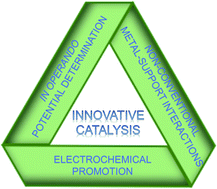Determination and perturbation of the electronic potentials of solid catalysts for innovative catalysis
Abstract
Concerns about energy and the environment are motivating a reexamination of catalytic processes, aiming to achieve more efficient and improved catalysis compatible with sustainability. Designing an active site for such heterogeneous catalytic processes remains a challenge leading to a next level breakthrough. Herein, we discuss a fundamental aspect of heterogeneous catalysis: the chemical potential of electrons in solid catalysts during thermal catalysis, which directly reflects the consequent catalytic reaction rate. The use of electrochemical tools during thermal catalysis allows for the quantitative determination of the ill-defined chemical potentials of solids in operando, whereby the potential–rate relationship can be established. Furthermore, the electrochemical means can also introduce the direct perturbation of catalyst potentials, in turn, perturbing the coverage of adsorbates functioning as poison, promoters, or reactants. We collect selected publications on these aspects, and provide a viewpoint bridging the fields of thermal- and electro-catalysis.



 Please wait while we load your content...
Please wait while we load your content...